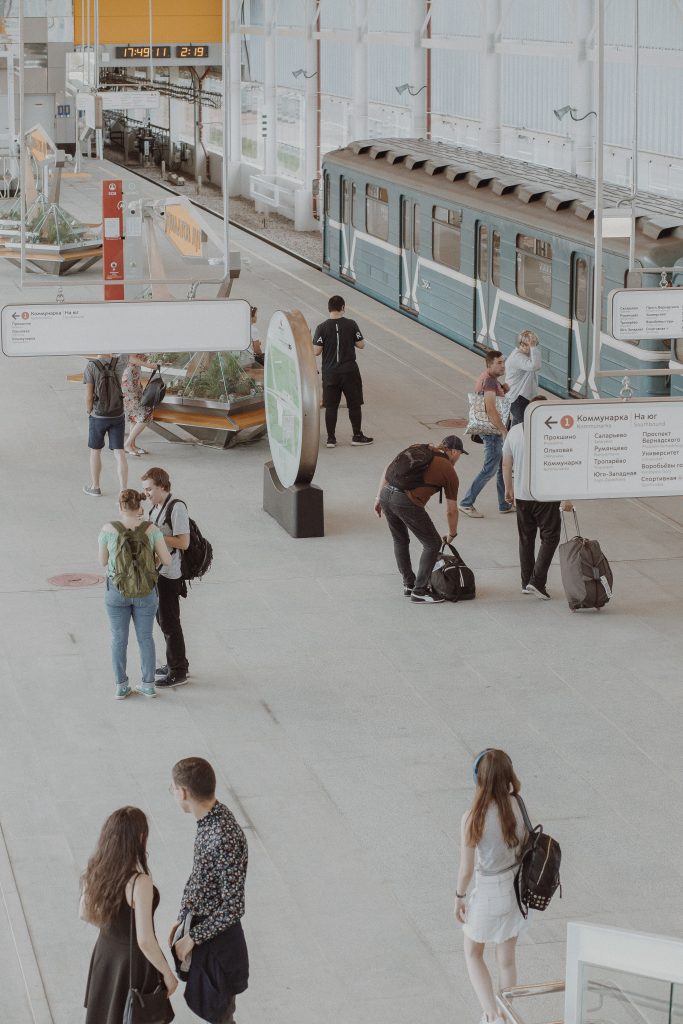Module 2: Expanding Your Intercultural Knowledge
Nonverbal Communication
Nonverbal signals can be classified under different categories based on what they involve. Some examples include eye behaviour (e.g., staring, gazing, blinking, winking, avoiding eye contact), touching behaviour (e.g., hugging, patting, holding, kissing, and punching) proximity to others, facial expressions, posture, appearance and meaning of colours, head and hand movements, pauses and hesitations, and vocalizations (e.g., laughing, sighing, groaning, and shushing). Each of the nonverbal cues we utilize is culturally constructed and may follow unwritten rules. For example, laughing is a cultural universal, but the way this is expressed across cultures is different. Laughing out loud on a public bus may be acceptable in many Latin American countries, but may be seen as disruptive behaviour in Norway or England. Similarly, greeting someone with two kisses may be the common rule in Spain, but those rules may not be applied in the same way in Muslim countries where people also greet each other with two or more kisses.
Activity: Understanding Nonverbal Communication
Watch the video Non-verbal Communication Across Cultures (5’45”), where Prof Alan Jenkins discusses, in the context of business, how understanding nonverbal communication is key when interacting across cultures. Pay attention to the examples he provides.
Answer the following True / False questions based on Prof Jenkins’ talk.
When we interact interculturally, our body language helps us get a message across and make connections, for example, through touch, closeness, eye contact, head movements, facial expressions, and gestures that indicate openness and interest in what is being said. We may not always be aware of how we come across when interacting with cultural others, therefore we are often quick to make assumptions about other people based on how we interpret their behaviour.
You have learned how unfair this can be. It is not that you or the other person is being disrespectful, forward, ill-intentioned, disinterested, shy, cold, or choosing to ignore your personal space; you are simply using different codes. That is, you are each communicating nonverbally in ways that are not necessarily shared across cultures.
There are numerous categories of nonverbal behaviours. In the following activity, we will explore gestures, personal space, and greetings to help you expand your knowledge and understanding of different ways to interpret nonverbal signals.
Gestures
Activity: Understanding Gestures
What do the following gestures mean to you? Do you know what meaning they may have in other countries? Print out the word worksheet Nonverbal Communication – Hand Gestures and write your interpretation of each gesture.
Now watch the video The Definitions of Hand Gestures Around the World (5’15”). As you watch, check your answers to see if you matched the meaning intended.
Think about this
- Were you able to interpret all the gestures correctly?
- Which of the interpretations came as a surprise?
- Were there any gestures that did not mean anything to you?
- Are any of these gestures offensive for you or in your culture?
- Which ones of these do you use? Which ones do you not use?
Here are further examples of nonverbal communication across different cultures. Have you ever been in a situation where any of these could have influenced the way you felt during an interaction? Can you think of a situation when you could have done something that may have made the other person uncomfortable?
Personal Space
How big is your bubble? Consider the following situations within the context of pre-pandemic times. Picture them in your mind and think about what you would do, if anything.
- You are standing in line in Starbucks to buy coffee and the person behind you is so close to you that if you take a step back you will step on their toes. How would you react? Would you do anything? Would you be comfortable ignoring it and just buy your coffee?
- At the end of a lesson, your professor is gathering their materials and you approach them to ask a question about a recommended reading. As you talk, you notice the professor carefully moves away from you while still talking to you and continues to do it every time you come close. You are certain that you are being polite and not doing anything wrong, how would you interpret this?
- You are sitting on a bench outside a library having your lunch and a person of the same sex sits on the bench where you are, even though there are other vacant benches around. Would you stay in that spot to finish your lunch? Would you feel more comfortable moving to another bench?
- Look at the following images, taken during normal situations BEFORE the COVID-19 pandemic. Where would you feel more comfortable? Would any of these be confusing to you? How would you feel in each situation? Would you follow the implicit rules for space you observe?
 Titov, M. (2020). Unrecognizable people in subway platform near train. Pexels. https://www.pexels.com/photo/unrecognizable-people-in-subway-platform-near-train-3848896/
Titov, M. (2020). Unrecognizable people in subway platform near train. Pexels. https://www.pexels.com/photo/unrecognizable-people-in-subway-platform-near-train-3848896/ Wright, W. (2019). People on Train Station. Pexels. https://www.pexels.com/photo/people-on-train-station-3412360/
Wright, W. (2019). People on Train Station. Pexels. https://www.pexels.com/photo/people-on-train-station-3412360/ Magni, O. (2019). People Standing Outside Stores. Pexels. https://www.pexels.com/photo/people-standing-outside-stores-2877106/
Magni, O. (2019). People Standing Outside Stores. Pexels. https://www.pexels.com/photo/people-standing-outside-stores-2877106/ Hank, F. (2014). People waiting at bus stop. WikiMedia. https://en.wikipedia.org/wiki/Bus_stop#/media/
Hank, F. (2014). People waiting at bus stop. WikiMedia. https://en.wikipedia.org/wiki/Bus_stop#/media/
File:People_waiting_at_bus_stop.jpg/ licensed under CC BY-SA 3.0.It is likely that people would react in a few different ways to each of these situations, but what are the implicit rules behind your reactions? What do you need to pay attention to? Each one of us carries an invisible bubble around that is culturally constructed. We learn about the right and appropriate distance to keep in our public, social, personal, and intimate interactions during our years of socialization, and this is fully established during adolescence.
Watch the video Cultural Proxemics. Personal Space (7’39”), the study of space behaviour across cultures, and as you watch, try to put yourself in the situation of each of the people you see so you can think about your own possible reactions.
Space is one of the most immediate ways to create approachability or discomfort when interacting across cultures. For example, people from countries like England, Germany, and even more so those from Sweden, Finland, or Norway are likely to leave significant space when conversing or in public (e.g., waiting for the train). Comparatively, people from Canada, the US, and Australia will seem comfortable with a shorter distance, while in Italy, Spain, Greece, most of Latin America, or Africa, the distance between you and another person will likely be much shorter, potentially even involving some touch while conversing to emphasize the message or form a connection between speakers.
Greetings
How do you greet people in your family? How about friends and peers at university/work? How many ways of greeting do you know? In what situations would you use them? With whom? Based on your experience and background, when is it appropriate to hug someone? Can you apply the same rules with anyone you know? Why?
Watch the video Greetings Around the World (2’45”) and observe the different ways people use to greet each other, which ones would you be comfortable mirroring if a person greeted you in a different way? What do you think people convey through greetings?
Greetings serve many functions and are part of our everyday interactions. They are a way for people to recognize and show appreciation toward others (e.g., friends), to show respect (e.g., to elders, people in authority), to introduce ourselves (e.g., to people at a party, to other students and co-workers), to welcome other people, to mark the start of a class or a conference, to observe respect through protocol and social conventions, and more.
Activity: Understanding Greetings
Look at the list of countries below and decide what kind of greetings people from those countries will likely use:
Think about this
- Have you ever been in a situation where you did not know how to greet others?
- How about a time when you felt confused or uncomfortable because greeting did not match the other person’s?
Greetings are learned behaviours, so if you make a mistake, it is okay! You can try again next time. You can learn about greeting conventions through observation and by asking people around you if you are unsure what to do. If you feel uncomfortable with any form of greeting and you are unable to reciprocate it, such as shaking hands or air kissing a person from a different sex, it may be better to explain to the other person that you are not used to their form of interaction. It is important to do so in a polite way to help others understand. If you find yourself in an intercultural situation and the other person seems uncomfortable with the way you greet them, perhaps try to explain that this is the way people commonly greet in that particular context and you want to make sure they understand and are comfortable with that. Oftentimes, it helps to wait and see if the other person initiates the greeting, then you can follow suit. It is a matter of being observant and adapting to the situation.
Takeaway points
- Most of our communication relies on nonverbal signals to emphasize, clarify, or enhance what we are saying with words. Nonverbal communication is classified into categories depending on the area they describe. For example, eye contact, head movement, facial expressions, hand gestures, and posture. We also communicate messages through colour, silence and other non-vocal sounds (e.g., grunting, sighing, and scoffing).
- Touching behaviour can be used to enhance relationships and make connections in some cultures (e.g., Brazil and Italy), whereas in other cultures, touching may be considerably reduced (e.g., England and Canada), avoided outside family and very close friends (e.g., Japan and South Korea), or considered inappropriate across different sexes (e.g., Muslim countries).
Try These Strategies
- When you are in a public place, for example, a shopping mall, or even better, at the airport, take a look around you and pay attention to people’s nonverbal behaviours. Notice the space they leave between each other. If there is any touching, how may people react if someone comes “too close”? You can also try this in an elevator or waiting room. Try to do this whenever you have the opportunity; this will help you develop your observation skills while you start to notice patterns and behaviours right in front of your eyes.
- When you are unsure of how to behave interculturally, try to let other people take the lead. Get used to adapting to differences. If you feel you have made a mistake, it is okay. We all learn by observing, trying, and asking!

